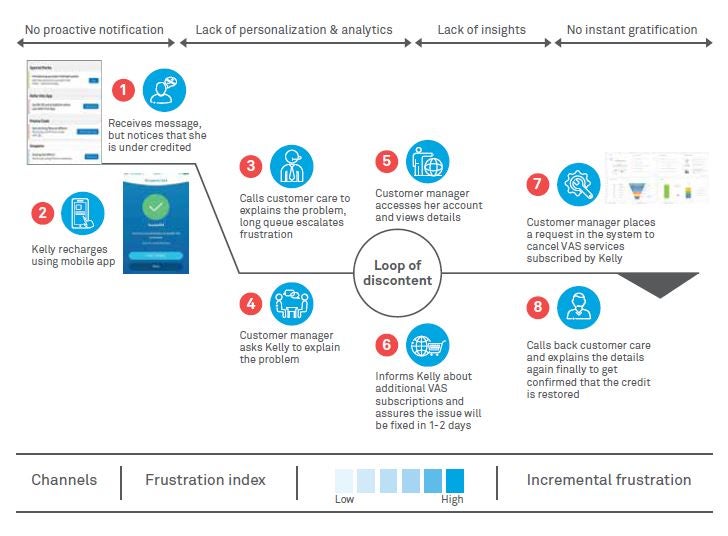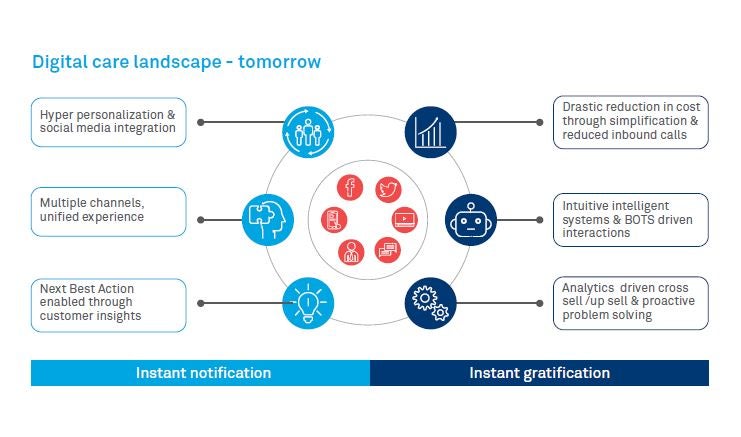Building the digital connect
Digital care is all about enabling customers to connect with the CSP through a channel of their choice, at any place and time. Enabling a consistent and seamless experience across channels and providing personalized care necessarily improves the experience. Digitizing customer care is not about eliminating human intervention, but bringing in the right mixture of digitally enabled human experience.
Analytics allows telcos to adopt an insight-driven approach to understand customer behavior, usage patterns, and their likes and dislikes. It helps telcos learn from the history of a particular customer engagement and provide more meaningful and contextual services, assist customers with ‘next best action’ and enable more cross sell/upsell opportunities.
Automation plays a pivotal role in improving operational excellence and rendering services with improved velocity and scale. Automating some of the highly repetitive, high volume tasks through robotic process automation (RPA) will allow customer-facing agents to focus on more high value calls and free up frontline resources for redeployment and future investments. Artificial intelligence (AI) platforms will bring in the much-needed cognitive and Machine Learning capabilities to enable autonomous solutions with enhanced productivity and agility. Some of the areas telcos might find these solutions to be useful are in process automation, rolling out virtual agents, building predictive engines for recommendations, etc.
Chatbots can be the digital concierge for customers, providing personalized care to customers at any time. They are agile in response and can mature into a more autonomous, decision-making state with the help of AI, and drastically free up some of the frontline investment to reduce huge operational costs. AI will ensure that the bots are adaptive in nature, learning and evolving continuously. Chatbots, available 24X7, can address scalability challenges well as they can handle multiple threads at the same time without breaks.
Injecting cognitive capability ensures that the virtual agents are able to converse with customers in natural language without sounding too robotic and are able to connect more empathetically with the customers. CSPs can improve their Net Provider Score, efficiency and drastically reduce a lot of call volumes by deflecting a part of the calls to chatbots.
Careful mapping of present day customer journeys to identify the pain points across channels and ‘right segmentation’ of customer profiles to derive persona-based journeys ensures that customer experience is consistent and relevant to all types of customers. The capability to differentiate customer experience based on personas and to reimagine their journeys accordingly across the channels they interact with, is a huge competitive advantage for telcos.
Social media plays a major role across the customer lifecycle since millennials flock the web for opinions and recommendations, to share and express their sentiments, and also to provide their feedbacks. Many telcos across the world are including social as a key channel to receive customer feedbacks and perceive social as a key medium to engage with their customers much faster and to reach out to them at scale.
Having an omnichannel experience is a huge boon to the telco business since customers can have multiple channels of their choice with the context and content being maintained across them seamlessly. Some of the key imperatives for an enhanced omnichannel experience are—the ability to maintain the identity of the customer across the channels and to integrate the customer data across these channels as a ‘single source of reference’; availability of a content management solution and sales catalog to drive consistency of products and services and to be synchronous across these channels; presence of an orchestration framework to push the recommendations and the content across these channels; and a knowledge management platform to harvest and store relevant content for the internal and external users.
Going digital is the game changer for the CSPs since it will help reduce inbound calls, improve KPIs and more importantly, address concerns of customers in a much more personalized and effective manner by tapping into customer insights.
In a highly competitive world, CSPs are already at the cusp of reimagining their customer care landscape where customer experience is the key. The ability to engage with the ‘customers of tomorrow’ will be the biggest differentiator in shaping up telcos’ future business.
Having an omnichannel experience is a huge boon to the telco business since customers can have multiple channels of their choice with the context and content being maintained across them seamlessly.
 Locations
Locations





